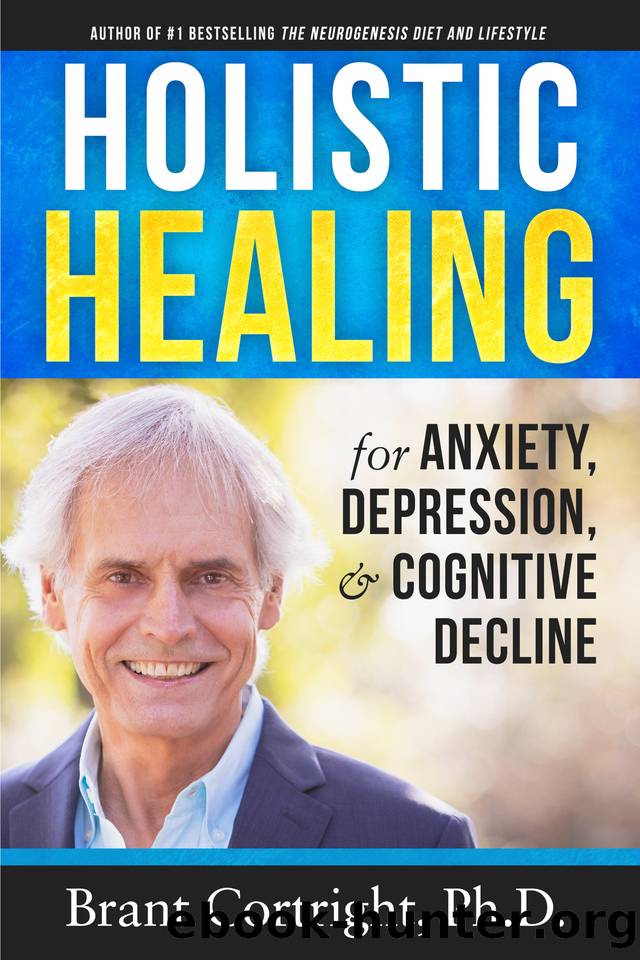Holistic Healing for Anxiety, Depression, and Cognitive Decline by Cortright Brant

Author:Cortright, Brant [Cortright, Brant]
Language: eng
Format: epub
Publisher: Psyche Media
Published: 2020-10-18T00:00:00+00:00
Chapter 4
Holistic Healing for Depression
Depression causes immense pain around the world. The number of people diagnosed with depression has increased by five to eight times in the last fifty years. According to the World Health Organization (WHO), depression is now the leading cause of disability and ill health worldwide, with over 300 million people suffering. 1
According to Blue Cross Blue Shield (BCBS), it has spiked by 33% in just the past five years (2013â2018), across all age and gender groups. Since most of those who are depressed also battle other conditions such as anxiety, chronic illness, or substance abuse, BCSC ranks depression behind high blood pressure as âthe second most impactful condition on the overall health of ... Americans.â 2 A 2017 Harris survey found two out of three Americans are not happy.
America is following the worldwide trend, as people who are depressed live an average of 9.6 years less, and the chief medical officer for BCBS predicts that âby 2030 depression will be the No. 1 cause for loss of longevity of life.â 2 The young are especially vulnerable. Between 2013 and 2018 depression has gone up 65% for adolescent girls, 47% for adolescent boys, and 47% among millennials.
What Is Depression?
Many people confuse occasional sadness or unhappiness with depression. Contrary to the images projected by modern media that thereâs something wrong if you donât feel happy all the time, feeling sad sometimes is a normal part of life. But depression is well beyond this, an almost unbearably painful, extended dark mood that continues for months or years.
On the inside, feeling depressed is a continuum. On the mild end depression is a prolonged, severe mood of feeling despondent, down, and despairing. As depression intensifies it moves into feeling worthless, hopeless, with difficulty concentrating and loss of pleasure in activities (anhedonia). It affects sleep and eating (vegetative functions), so the person sleeps either more or less and eats either more or less. There may be thoughts of suicide or death. As depression worsens it gets progressively bleaker, darker, more isolating and painful. Toward the more severe end it descends into complete darkness, utter futility, and loss of motivation. It becomes hard to move or get out of bed. At the far end it becomes deadness and complete numbness.
From the outside, while âdepressionâ is often used as a catch-all to include any type of not feeling well, the Diagnostic and Statistical Manual, 5th Edition (DSM-V) identifies numerous types of depression. A depressed mood or loss of interest or pleasure must be present for at least two weeks.
Diagnosis is based on how a person feels and behaves. There is no blood test or brain scan to diagnose depression. For this reason, itâs always advisable to get a complete medical checkup to rule out any illness that may be presenting as depression. For example, low thyroid or chronic fatigue syndrome can look identical to depression.
Types of depression include:
⢠major depressive disorder
⢠persistent depressive disorder (dysthymia)
⢠adjustment disorder with depressed mood
⢠seasonal affective disorder (SAD),
Download
This site does not store any files on its server. We only index and link to content provided by other sites. Please contact the content providers to delete copyright contents if any and email us, we'll remove relevant links or contents immediately.
| Administration & Medicine Economics | Allied Health Professions |
| Basic Sciences | Dentistry |
| History | Medical Informatics |
| Medicine | Nursing |
| Pharmacology | Psychology |
| Research | Veterinary Medicine |
Periodization Training for Sports by Tudor Bompa(7934)
Why We Sleep: Unlocking the Power of Sleep and Dreams by Matthew Walker(6371)
Paper Towns by Green John(4811)
The Immortal Life of Henrietta Lacks by Rebecca Skloot(4269)
The Sports Rules Book by Human Kinetics(4086)
Dynamic Alignment Through Imagery by Eric Franklin(3928)
ACSM's Complete Guide to Fitness & Health by ACSM(3829)
Kaplan MCAT Organic Chemistry Review: Created for MCAT 2015 (Kaplan Test Prep) by Kaplan(3810)
Introduction to Kinesiology by Shirl J. Hoffman(3632)
Livewired by David Eagleman(3540)
The River of Consciousness by Oliver Sacks(3423)
The Death of the Heart by Elizabeth Bowen(3347)
Alchemy and Alchemists by C. J. S. Thompson(3303)
Descartes' Error by Antonio Damasio(3168)
Bad Pharma by Ben Goldacre(3112)
The Emperor of All Maladies: A Biography of Cancer by Siddhartha Mukherjee(2939)
The Gene: An Intimate History by Siddhartha Mukherjee(2933)
The Fate of Rome: Climate, Disease, and the End of an Empire (The Princeton History of the Ancient World) by Kyle Harper(2882)
Kaplan MCAT Behavioral Sciences Review: Created for MCAT 2015 (Kaplan Test Prep) by Kaplan(2826)
